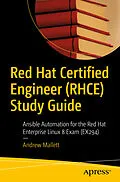Study the material in this book to prepare for the RHCE exam EX294 and to learn how using Ansible within your own environment improves system administration productivity.
This book covers all of the objectives of the exam and extends further, ensuring that you know how to use Ansible to manage Linux. The book uses CentOS, a Red Hat-based distribution, and Ubuntu instead of using a single Red Hat distribution. By using the two distributions, you will understand the power of Ansible and how easily you can deal with multiple platforms, which is crucial for your understanding of Ansible in the real world.
The book assumes no previous knowledge of Ansible but some knowledge of Linux system administration from the command line. You will learn how to manage Linux systems that are installed with different distributions, including CentOS Enterprise Linux 8 and Ubuntu 18.04. You will be able to manage these systems using ad hoc commands from the command line as well as creating Ansible playbooks that can be replayed reliably many times. To save on the code that you have to create, you will learn how to use Ansible Galaxy to search for and download roles and collections that are pre-written to manage elements of your Linux installations. By the end of this book, you will be able to write efficient and effective YAML playbooks to manage your entire estate.
You will:
- Prepare systems so that password-less access can be used with Ansible remotely
- Use ad hoc commands to quickly configure systems
- Use and format YAML files correctly
- Create playbooks that grow in their complexity as your experience develops
- Ensure that services are restarted on configuration changes
Autorentext
Andrew Mallett is a well-known Linux consultant and trainer, and his YouTube Channel has over 65K subscribers and more than 1,000 videos. Working mainly online now, he has authored courses on both Pluralsight and Udemy, and regularly teaches classes online to a worldwide audience. Andrew is familiar with Linux and UNIX and has worked with them for over 20 years. Scripting and automation is one of his passions as he is inherently lazy and will always seek the most effective way of getting the job done. The Urban Penguin, his alter ego, is a UK-based company where he creates his work and currently employs five people.
Inhalt
Chapter 1: Understanding Ansible and the Red Hat RHCE
Chapter Goal: Help the reader identify the course of the book and what they need to follow along
No of pages 10
Sub -Topics
1. Ansible and Red Hat
2. Red Hat Certifications
3. Lab systems used in the book
4. Investigating the Lab Systems
5. Installing Ansible on CentOS 8
6. Installing Ansible on Ubuntu 18.04
Chapter 2: Working with the Ansible ConfigurationChapter Goal: Gain and understanding a create Ansible configuration file and enforce their use with read only variables
No of pages: 10
Sub - Topics
1. Identify the version of Ansible and the location of the configuration file used
2. Understanding the Ansible configuration hierarchy
3. Configuring read-only variables
4. Printing Ansible configurations
5. Creating basic configuration
Chapter 3: Creating an Ansible InventoryChapter Goal: The inventory is a list of hosts that will be managed for that project. The reader will learn to create the inventory both manaualyy and automated searches. Inventory groups allow for more directed targeting of tasks.
No of pages : 10
Sub - Topics:
1. Adding hosts to the inventory2. Using NMAP to discover SSH hosts and add to inventory
3. Creating inventory groups4. Printing inventory entries
5. Implementing host and group variables
Chapter 4: Using ad-hoc commands and Ansible preparationChapter Goal: Allow the reader to start using ansible and prepare for more automated use
No of pages: 10
Sub - Topics:
1. Generating a local ssh key pair2. Testing Ansible connections
3. Using Ansible to distribute the user's public key
4. Enabling password-less access to sudo
5. Gaining invaluable help on Ansible modules
6. Creating and removing users with Ansible
Chapter 5: Writing YAML and Basic PlaybooksChapter Goal: Playbooks are written n YAML so it is important to understand how to write YAML files and basic playbooks
No of pages: 10
Sub - Topics:
1. Understanding YAML files
2. Configuring the VIM text editor for YAML
3. Using Microsoft Visual Code to edit YAML files
4. Creating a simple Ansible playbook
5. Using facts in playbooks
Chapter 6: Managing Users in Ansible PlaybooksChapter Goal: Something that is to understand and user is to create and manage users with Ansible. The user password needs to be encrypted and we can generate encrypted passwords in many ways including Python and C
No of pages: 15
Sub - Topics:
1. Using playbooks to create and remove users
2. Creating multiple users with loops
3. Using variables in playbooks
4. ...
